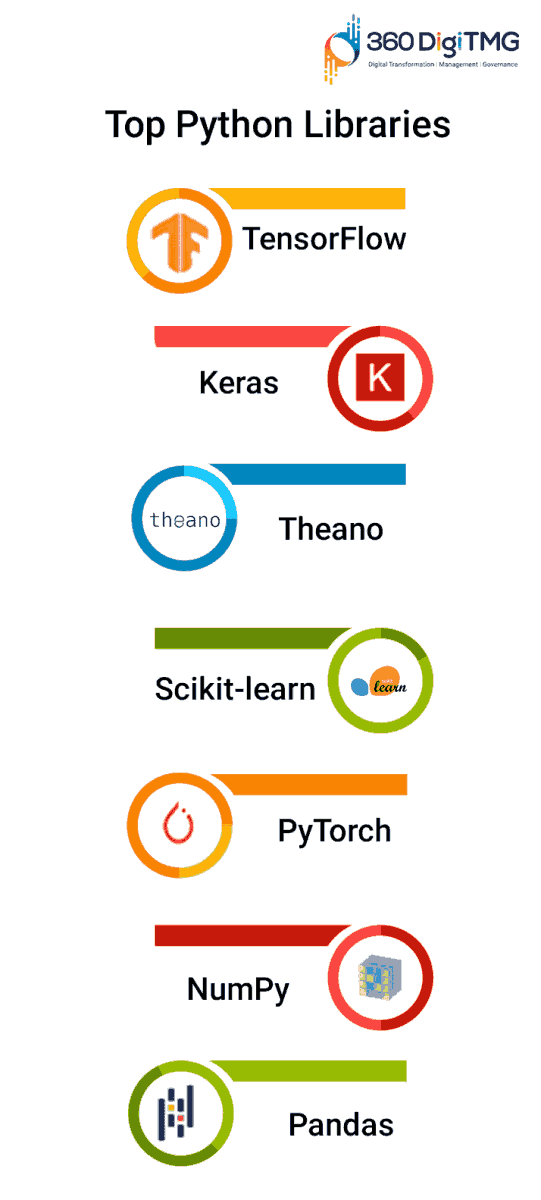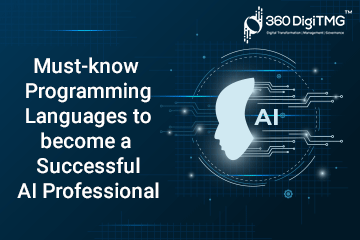Home / Blog / Artificial Intelligence / Must-Know Skill for AI is Python and its Relevant Libraries
Must-Know Skill for AI is Python and its Relevant Libraries

Table of Content
Must-Know Skill for AI is Python and its Relevant Libraries
The way organisations operate and think has altered as a result of Artificial intelligence and machine learning. Businesses are actively investing in it in greater numbers. It aids businesses in gaining insightful knowledge from data.
You must select a programming language in order to work with ML and AI. The model may be trained in a wide variety of languages. The most often used language is Python. We shall learn more about Python and its libraries in this post.
Click here to explore 360DigiTMG.
Why is Python Preferred for AI?
Python is widely used in the AI world. There is a huge community of developers who are working on making it better day by day. So let’s first find out why we use Python.
- A great library ecosystem: Python has a large number of libraries. A type of code called a library is one that may be used by your system directly. The creation of Python libraries is the focus of many developers worldwide.
- Easy to learn: Python is very beginner-friendly. If you are a beginner, you should start programming with Python rather than Java, C or C++.
- Flexibility: Python provides you the choice of using OOPs or scripting. To accomplish your objectives, you can combine Python with other high-level languages.
- Platform independence: Other than being easy to learn and flexible Python is very versatile. Python can be used in a variety of platforms like MacOS, Windows, UNIX, Linux, and twenty others.
- Community Support: A sizable population has gathered around Python. The usage of all the main libraries is likewise free.
Python Language Features
-
Interpreted
- Python does not have any separate compilation step like C or C++.
- You can directly run the program from the source code.
- You don’t have to take care of the loading and linking of the library.
-
Platform Independent
- Python can be used in multiple operating systems.
- It can be used in macOS, Windows, Linux, Solaris and many more.
- Python is free and open-source.
-
Simple
- Python is very close to the English language and easy to learn.
-
Embeddable
- Python can be used within other language programs like C and C++.
-
Python has a Rich library Support.
Applications of Python
- Web Applications: Python may be used to develop a wide variety of online applications and content management systems. Flask, Plone, Django, and Pyramid are a few suggested frameworks for building online applications.
- Scientific and Numeric Computing: Python abounds with libraries for scientific and numeric computing. Libraries like SciPy and NumPy can be used for general computation. You can use EarthPy for Earth science. You have AstroPy for astrology and so on.
- Creating Software Prototypes: Prototyping is frequently done in Python. Your game's prototype may be made with Pygame.
Python vs. C++ for AI
- Python is more famous than C++ in the developer community. The reason behind this is that Python is easy to learn and implement.
- Performance-wise C++ is better than Python. The reason behind this is that C++ is a statically typed language. Hence, typing errors are minimal in this case. Moreover, C++ creates faster programs.
- Python can be used to implement functionality even with less code. Python is dynamic while C++ is platform-specific.
- The development of the GPU has given Python an edge over C++.
Top Python Libraries

1. TensorFlow
To carry out difficult numerical computations, TensorFlow is employed. It is capable of partial differential equation (PDE), word embedding, deep learning, neural networks, image recognition, handwritten digit classification, and natural language processing (NLP).
Abstraction is the major advantage of utilising TensorFlow. This enables programmers to concentrate on logic and leave the computer to handle the specifics of algorithm implementation. You may use it to make one-of-a-kind, responsive apps that you can use on desktop, Android, or iOS platforms.
Advantages of TensorFlow:
- TensorFlow provides better graph visualization techniques.
- TensorFlow is backed by Google. You can get regular updates and new features.
- TensorFlow can be used in a wide variety of platforms like Windows, Linux, macOS and even smartphones.
2. Keras
An open-source library called Keras is used to build machine learning applications like neural networks. It is compatible with MXNet, Deeplearning4j, TensorFlow, Theano, and Microsoft Cognitive Toolkit (CNTK). It includes nearly all required components, such as neural layers, optimizers, initialization plans, functions for activation, cost functions, and regularisation strategies.
With Keras, adding new modules is a breeze. The process is analogous to adding new classes and functions. There is no requirement for separate model configuration files because the model is described in the code.
Due of its simplicity of usage, newcomers typically like Keras. Even convolutional neural networks may be handled by it. Modularity and expressiveness are improved with Keras. It has algorithms for the layers of normalisation, activation, and optimizer.
Advantages of Keras:
- The developer’s experience is given priority in Keras.
- Keras is widely used in the industry and research community.
- Keras makes it easy to turn your model into products.
- Keras supports multiple backends. You can choose any one backend as per your requirement.
3. Theano
- Theano was developed in the year 2007 and since then it has always been a must-know library in the AI community.
- Theano allows you to deal with a multidimensional array. It is extensively used in scientific and complex mathematical calculations.
- With Theano you can perform data-intensive calculations a hundred times faster than your CPU alone. Moreover, it is optimized for GPU as well. In simple terms, the developers have tried their best to make Theano a go-to option when dealing with large calculations regularly.
- Theano has proved to be a great neural network library because of its fast computations. It can be used to boost the computation time and development time of AI apps. However, it has a disadvantage of being quite hard for beginners.
Advantages of Theano:
- Theano can be used to stabilize unstable models.
- In Theano you can optimize the speed by moving from CPU to GPU.
- Theano can automatically create your symbolic graphs to make data visualization easy.
4. Scikit-learn
Another essential Python package is called Scikit-learn. It has a wide variety of methods for classification, grouping, and regression. Examples include gradient boosting, DBSCAN, random forest, k-means, and vector machines. It is compatible with SciPy and NumPy, two additional Python libraries.
This well-known AI library is available for purchase.
Here are the advantages of Scikit-learn:
- Dimensionality reduction
- Decision tree pruning
- Feature selection & analysis
- Clustering
- Unsupervised classification
- Outlier detection
- Induction
- Decision boundary learning
5. PyTorch
In a very short period of time, PyTorch has managed to capture the interest of the AI community. A large community of software developers supports PyTorch.
Applications like Natural Language Processing (NLP) frequently employ PyTorch. Similar to Theano, it may be applied to both the CPU and the GPU. A GPU is the best choice if you want quicker processing.
Glow is another compiler that comes with PyTorch.
Advantages of PyTorch:
- A dynamic approach to graph computation
- Fast deep learning training
- Better developer productivity
- Easier and simple to learn
- A community of focused developer
- Transparency
- Easy to debug
6. NumPy
Numerical Python is referred to as NumPy. The usage of it is in linear algebra. This library is used by well-known libraries as Matplotlib, Scikit-learn, SciPy, etc. It is capable of handling challenging mathematical processes including the Fourier transformation, linear algebra, and n-array and matrix functions.
Numerous scientists using NumPy to carry out their computations. Images, sound waves, and other binary functions may all be handled with it.
Advantages of NumPy:
- Contiguous allocation in memory
- Boolean selection
- Vectorized operations
- Sliceability
7. Pandas
Nearly 90% of the time spent on machine learning is spent on data analysis and pattern recognition. Pandas get the developers' attention at this point.
A wide range of tools for data analysis and manipulation are available with Pandas. Python can read data from a wide variety of sources, including SQL databases, CSV, Excel, and JSON files.
With just one or two commands, you can control complicated tasks. Pandas should be used in a Jupyter notebook because of how user-friendly the interface is. But it also functions in other text editors.
Advantages of Pandas:
- Convenient data filtering
- Can handle huge volumes of data
- Series and DataFrame data structure
- Can handle a variety of formats like TSV, MS Excel, CSV, etc.
That's all there is to know about Python and the necessary libraries. We've spoken about what Python is, why we use it, why it's superior than C++, and some of its uses. Next, we covered the seven most popular Python libraries: TensorFlow, Keras, Theano, Scikit-Learn, PyTorch, NumPy, and Pandas.
Data Science Training Institutes in Other Locations
Navigate to Address
360DigiTMG - Data Science Course, Data Scientist Course Training in Chennai
D.No: C1, No.3, 3rd Floor, State Highway 49A, 330, Rajiv Gandhi Salai, NJK Avenue, Thoraipakkam, Tamil Nadu 600097
1800-212-654-321


.jpg)

